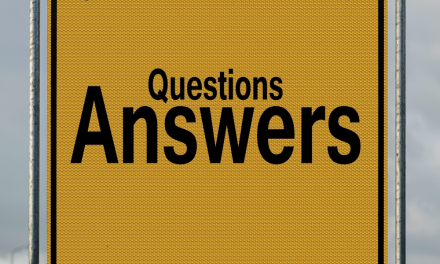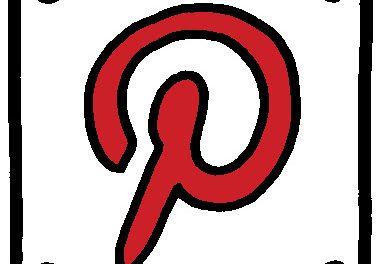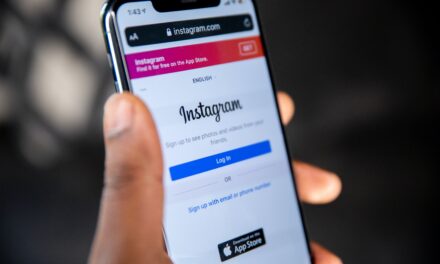“Imitation is not just the sincerest form of flattery – it’s the sincerest form of learning.”
― George Bernard Shaw
The reason this post will show you a whole bunch of successful FB ads from many different niches, is because until you have an unlimited amount of time and a budget big enough to build a battleship…
It’s best to find out what is working already and model it. Before we get to the ads, a quick note on modeling.
Modeling is not copying. Modeling is studying the fundamental principles of something that is proven to work and then using those principles to create something unique.
There are three parts to this article. First, we’ll dig very deep into one winning ad. Second, we’ll take a broader approach to several winning ads. And to finish, I’ll show you step by step how to construct an ad based on those winners.
The key takeaway from all of these ads is how well the companies/individuals know the needs of their customers.
Knowing what your customer wants means you can join the conversation already happening in their head.
And a prime example of joining the conversation already going on in a customer’s head can be found in our first ad.
#1 Fresh Books – The Direct Benefit Ad
The goal of this ad is to get new customers to sign up for a trial of the Freshbooks invoicing software.
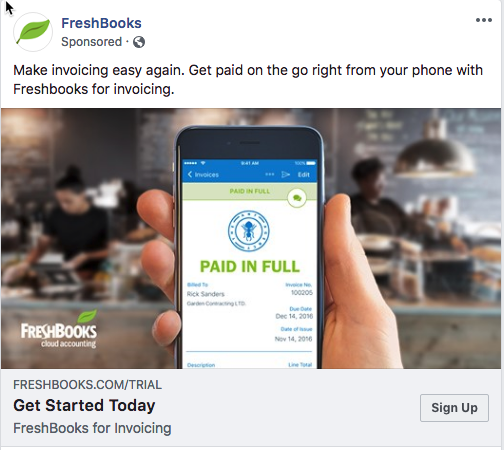
The first sentence of this ad is just four words. Four words which use a presupposition. A presupposition can be defined as: something you believe is true without any proof.
“Make invoicing easy again”
These four words are presupposing that invoicing has become difficult.
There is an immediate appeal, then, to anyone who is not satisfied with their current arrangements to send invoices and collect payments.
Anyone who’s having a bad time with invoicing has probably had their attention captured by those four words.
Now, they want the payoff.
The next sentence builds on the momentum of the first by offering a clear benefit, or a payoff, for continuing to read (which, again, presupposes that if you use Freshbooks, you will get this outcome) by saying that you can get paid on the go right from your phone.
Only at the end of the second sentence does the ad link the benefit to the company offering the solution.
“Get paid on the go right from your phone with Freshbooks for invoicing”
(And further down, we’ll look more closely at those three words, “Freshbooks for invoicing”.)
Then there is the image.
The image is a point a view shot. It feels like the viewer is looking at their phone. And, of course, the message is something we all like to see…
“PAID IN FULL”
Notice how the words “paid in full” are congruent to the entire advert. If we take the words “paid in full” and add them to the previous sentences, we get the following:
Make invoicing easy again.
Get paid on the go right from your phone with Freshbooks for invoicing.
PAID IN FULL
That’s an entire journey in two sentences and one image. I wonder if you see how clever the ad is?
But we’re not finished with the image yet, did you notice the slightly blurred background?
The background looks like a coffee shop. Or, at least somewhere that is not a cubicle farm or standard office.
Next, we have the call to action below the image.
Which reads…
Freshbooks.com/TRIAL (URL)
Get started today.
Freshbooks for invoicing.
And the button on the right hand side uses the microcopy “Sign Up.”
There is a lot going on here.
The URL Freshbooks.com/TRIAL immediately tells me that if this is a service I want, then I can trial it. Of course, I need to click through to the offer page to find out the details of the trial.
Next, we read how it’s quick and simple to get our hands on the product with the three words, “Get started today.”
Then, to finish, we have the three words, “Freshbooks for invoicing.” And I said we’d look at this more closely.
These three words are what we call positioning. These three words are positioning Freshbooks with invoicing. Very simple and very powerful, in fact, much more powerful than if they were to make a claim like…
“Freshbooks is the world’s number one invoicing software” — There is just too much for the reader to disagree with there.
Finally, the call to action button tells me that if I click it, I’m going to a sign up page. This removes any surprises from what is going to happen next.
Chances are if I click that button, I want to find out more about the trial and sign up.
To finish off, let’s look at all the copy used in the ad including the copy in the image.
Make invoicing easy again.
Get paid on the go right from your phone with Freshbooks for invoicing.
PAID IN FULL
Freshbooks.com/TRIAL
Get started today.
Freshbooks for invoicing.
Sign Up
That’s a total of 29 words.
I wonder how many words you’re considering using in your next Facebook ad?
#2 Neil Patel – The Emotional Advert (you’re the same as me)
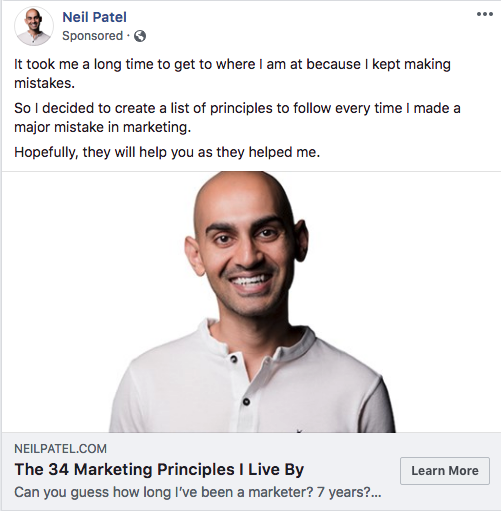
The goal of this advert is to get people to read a blog post about marketing principles.
The way it attracts the reader to take action is by saying you’re the same as me.
Everyone makes mistakes. There is no escaping that. It cannot be argued. And Neil Patel is coming straight out and saying he’s made mistakes.
“It took me a long time to get where I am because I kept on making mistakes.”
Let’s break that opening sentence down. It might just as well read, “YOU are taking a long time to see success because you are making the same kind of mistakes I did.”
“So, I decided to make a list of principles to follow every time I made a major mistake in marketing.”
The second sentence might as well read, “Because I have already made these mistakes, I can show you (possibly) how to avoid making them,” or “If you have made a mistake, even if the mistake you’ve made is a major one, these principles can help you.”
“Hopefully they will help you as they helped me.”
The third sentence takes the edge off of what he is going to tell you and lets you know it is as good as gospel. That’s achieved with the word hopefully.
Next, the image is a man in casual clothes smiling. The image says I’m just a dude out in the world doing my best. I’m just like you. I wonder if you can relate to the image?
Finally, the call to action sharpens the image of what is coming next by stating that Neil Patel has 34 Marketing Principles he lives by.
The call to action button says, “learn more.” This means you know what is coming next if you click on the call to action button. Yep, you guessed it…
A blog post titled, “The 34 Marketing Principles I live by.”
#3 ClickFunnels – The, Quick, Easy, and Cheap Way To Do Something You Hate (But Have To Do)
The goal of this ad is to get people to register for a webinar.
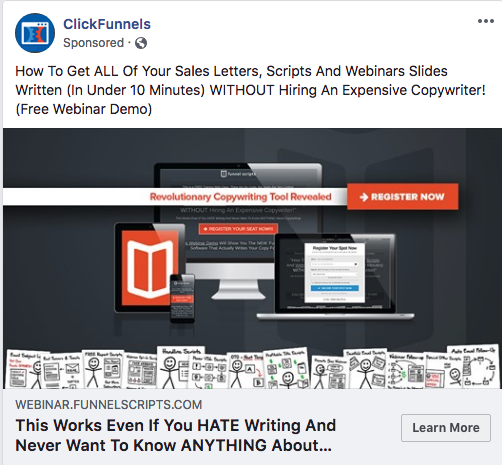
Before we delve into what this ad offers, let’s think back to something we mentioned at the start of this article.
The key takeaway from all of these ads is how well the companies/individuals know the needs of their customers.
Now, I’m assuming you’re an affiliate marketer or marketer, and you use funnels as part of your business model.
Which of these tasks (if any) gives you a headache:
Writing sales letters
Writing scripts
Creating webinar slides
Unless you’re a copywriter, then like most people, you dislike at least one of those three tasks. Maybe you don’t, but for most people, those are the three biggest bugbears.
Which means Clickfunnels knows their customer’s pain points.
They know how long it takes to create these things, which is why they say (in not so many words as I’m going to use) that if you watch their webinar, you’ll learn how to do it in less than 10 minutes.
This ad is very tempting to anyone who spends hours putting these creatives together.
Next, notice how Clickfunnels creates an enemy. Did you spot the enemy?
The enemy is the EXPENSIVE COPYWRITER.
Now, there is a reason that copywriters command big bucks (Good copywriters that is), but Clickfunnels knows that a huge percentage of their customers are either looking for a complete DIY solution, a budget option, or don’t feel confident enough in employing a copywriter. That is why the enemy is the expensive copywriter.
So, once more, I should reiterate the key point in this article. Knowing what your customer wants gives you all the information you need to create a great FB ad and every other piece of content such as blog posts, emails, etc.
#4 Mailchimp – The Compliment What You’re Already Doing Approach
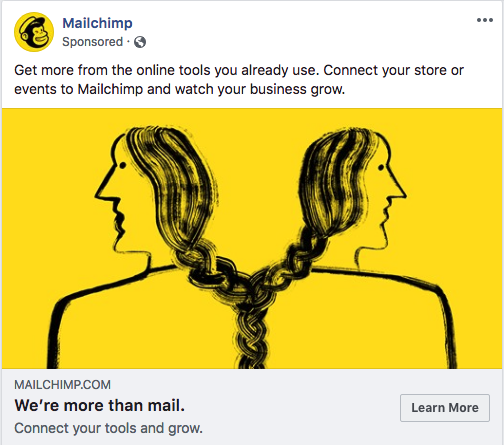
“Get more from the tools you already use. Connect your store or events to Mailchimp and watch your business grow.”
This ad is curiosity based. It presupposes that you are already using tools. But what tools?
Also, this ad is not trying to sell you on a replacement. It’s positioning itself as an enhancement to your efforts.
Now, I’ve stared at the image for a long time. I was trying to figure out if it was an illusion image where you see one thing and another thing appears. Either way, I stared at the image for a long time!
The call to action is again curiosity based.
We’re more than email.
And the button text tells me that if I click, I will learn more.
So right now as I read this ad, there are lots of open loops — or the Zeigarnick effect, if you want to get technical.
Which of my tools can I connect?
What do you do that is more than just email?
How can you help me grow?
What do they know that I don’t know?
#5 BEirresisitible – The Joining The Story In Their Head Approach
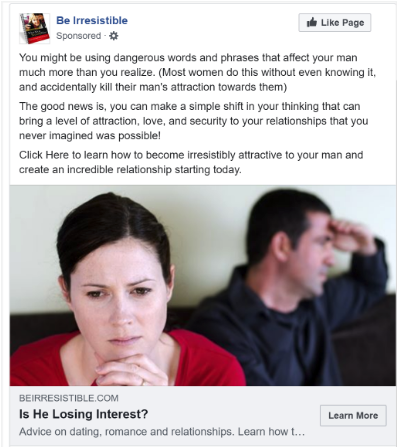
There is a lot more text to this ad than the previous ads we’ve looked at.
This ad attempts to join the story that is happening inside the prospect’s mind.
Let’s look at the text in full and then break it down.
“You might be using dangerous words and phrases that affect your man much more than you realize. (Most women do this without even knowing it, and accidentally kill their man’s attraction towards them)
The good news is, you can make a simple shift in your thinking that can bring a level of attraction, love, and security to your relationships that you never imagined possible!
Click here to learn how to become irresistibly attractive to your man and start and create an incredible relationship starting today.”
Okay, before we breakdown the text, take a look at the image one more time. What does that image say to you? Do you feel it represents what is being said in the text?
Then we have the call to action text.
Is he losing interest?
If someone looks at this advert but does not read the text, say they only look at the image and the bolded text, which says, “is he losing interest?” Do you think they get the message of what the ad is about?
Let’s return to the main text.
The first paragraph is joining the conversation going on in peoples’ heads.
“You might be using dangerous words and phrases that affect your man much more than you realize. (Most women do this without even knowing it, and accidentally kill their man’s attraction towards them)”
People in relationships do think to themselves, is it something I’ve said, or something I’m doing wrong. So the sentence, “You might be using dangerous words and phrases that affect your man much more than you realize,” connects with people.
The next sentence does two things. First it removes blame. “Most women do this without even realizing.”
The second thing it does is suggest that you are like most women, and you are doing something unconsciously that is damaging your relationship.
So the first paragraph connects with the target audience, highlights a problem, and introduces an element of fear. It also presupposes that if you don’t find out what you’re doing, then you’re not going to be able to fix your relationship issues.
As a point of note, the ad does not attempt to scare people. What it does is connect with human emotions in the way people are trained to receive them.
Our brain is wired to find problems, so we can avoid danger and pain. Before we fix things, we want to know there is a problem. And before we trust someone to help us fix that problem, we want to know that they understand the pain we are suffering.
If this first paragraph was missing, then the second paragraph would lose almost all of its impact.
The next paragraph offers relief. And it offers relief in the simplest and easiest way possible. I’ve underlined the words that show what the reader must do to move away from the pain they are in and improve their relationship.
“The good news is, you can make a simple shift in your thinking that can bring a level of attraction, love, and security to your relationships that you never imagined possible!”
Let’s further dissect that second paragraph.
“The good news is” = Instant relief. We’ve recognized there is a problem, and now it’s time for the good news (or solution).
“You can make a simple shift in your thinking” = This is all you have to do. Think in a different way. How stress free is that?
“That can bring a level of attraction, love, and security to your relationships that you never imagined possible!” = Benefit, benefit, benefit.
The Insider Affiliate Step-by-Step Method For Creating FB Ads That Almost Force People To Click Through To Your Offer
- Open up a fresh document in a word processor of your choice.
- Set up your writing space with the following headers
- Ad text
- Link description
- Headline
- Display link
- Call to action
- Close all other tabs and remove any distractions to get those creative juices flowing
- Set a timer for 25 minutes (type 25 minute timer in a Google tab if you’ve no other way of timing 25 minutes)
- Start writing
- Write down every crazy, insane, dumb, might work, or just plain silly idea you can think of in relation to your niche. Honestly just blast out as much information as you can think of.
- Think of how you want to join the conversation in peoples’ heads. This is going to give you the text at the top of your ad.
- Choose an image
- Look back at the examples in this post for choosing an image
- Create the headline
- The headline needs to be punchy and short
- Choose your call to action text
- Open up FB ads manager
- Follow the instructions for budget and targeting
- You can then make your ad live. So you will see the changes as you make them
- Publish your ad

